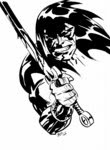Screengrab - "Its my manor!"

I watched the end of The Long Good Friday on tv the other night. I've seen it before - on video and in a cinema when the BFI rereleased it in the late 90s. Its a fine film, well directed and with a good solid screenplay, even if it is stylistically a little dated. It is effectively an elevated TV movie, with writer Barrie Keefe and director John MacKenzie both British television veterans, and it feels like one for the most part, MacKenzies odd flashes of ostenstatious technique apart. But even its dated quality works in its favour, somehow. It seems to capture a specific time and place in a way that only film can, with its fashion styles and haircuts and the weird synthesised jazz-rock on the soundtrack. Nothing dates a film like a wailing saxophone. Its incredibly prescient, too, in its handling of the issue of London's Docklands development, and even in its use of the IRA as a gangland force as much as a Political Group. But the true and obvious glory of the film is Bob Hoskins' performance.
Hoskins has a unique presence, and few directors seem to understand how best to use him. In American films he tends to be used to play larger-than-life figures, perhaps because he is a type Americans are not accustomed to. He has played Mario (as in Super), Mussolini, Noriega, J. Edgar Hoover, Sancho Panza, Smee in Hook and effortlessly acted opposite a world of cartoon characters in Who Framed Roger Rabbit? In truth, there is something larger than life about him, a huge energy and vigour in such a small man, and a sometimes frightening intensity in his eyes. He is better understood and better used in British cinema. Neil Jordan tapped the vulnerability and tenderness beneath the bulldog surface in Mona Lisa, and Shane Meadows exposed the proximity to madness in those terrible rages we have seen in many performances in Twentyfourseven. But The Long Good Friday, and the role of Harold Shand, fit him better than any other. The way he is constricted by the suits he wears, his absence of a neck making his head sit upon those squat shoulders reveals as much about Harold as anything he says. Indeed, much of Hoskins' best work in the film is entirely silent, the story told only by his changing expressions, his perfect body language. The way his nostrils flare when he angers and how often he has to fight his own temper, the way his bottom teeth jut out when he is stressed, his barely suppressed fury, are all evident just by watching Hoskins charge through the film. When his rage does erupt, in the scene where he attacks his right-hand man, Parky, with a bottle, it is terrifying and yet saddening too.
But he also has some great dialogue to wrap those London vowel sounds around, especially his famous farewell speech to his prospective American partners, which ends with the following lines: "The Mafia? I shit 'em." Helen Mirren provides him with the perfect foil, just as powerful and passionate as he, but doing a better job of hiding it. They have real chemistry, too, and its almost understandable why a woman as classy, poised and sexy as Mirren is with such a lowlife bit of rough as Hoskins in their scenes together. That depth of feeling gives The Long Good Friday more emotional power than most of the English Gangster films that have sought to ape it.
The films best moment, though, is its final scene, where Harold, believing that he has defeated his IRA tormenters, is picked up by what he thinks is his car outside the Savoy Hotel after that confrontation with the Mafia. Once in the car, he realises that he has been abducted by the IRA. A young Pierce Brosnan grins at him from behind a gun in the passenger seat. The last minute or so of the film is nothing but an unchanging shot of Hoskins' face as he realises what is happening to him. Hoskins says nothing, the camera doesn't move or cut away. The streetlights and glow of traffic in the rear window behind his head flicks and drags by, and Harold processes what is about to happen. Hoskins is amazing in this scene, allowing incomprehension, then understanding, then the familiar look of rage to pass across his face in a few seconds. The nostrils flare, the lower teeth jut out, his eyes glare. Then it falls away, and Harold accepts his fate. He looks calm, almost amused for a second. A flicker of fear perhaps, trepidation. The soundtrack, after an initial surge of sax and drums, has quietened to a sort of pulse as we watch Harold in his last moments. It would be impossible to look away, and the camera seems as gripped by Hoskins as any audience must be. You almost don't want the shot to end. Its a bravura moment of film-making, risky and courageous, and it means that you leave The Long Good Friday on a sort of high, exhilarated by the power of the medium itself, and especially by the power of great acting.
Labels: film



0 Comments:
Post a Comment
<< Home